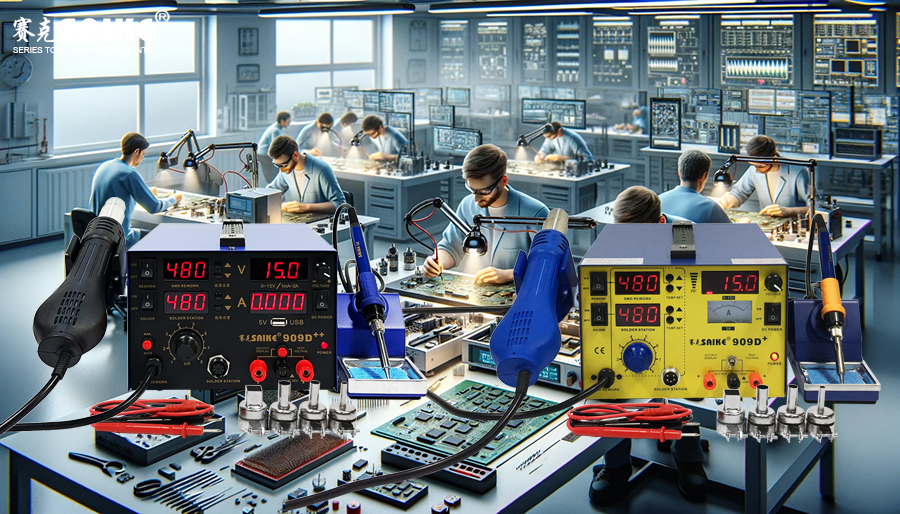
SK-YJ000RFSHY-KP 100003
The DC regulated power supply is a common device used in electronic laboratories and circuit design. Its main function is to provide a stable DC voltage and current to meet the needs of different electronic devices and circuits. The components of the DC regulated power supply each have important functions. This article will introduce these components in detail, including output ports, display screens, control panels, etc.
I. Output Port
The output port is the interface between the DC regulated power supply and the powered device or circuit, which mainly includes the following types:
1.Banana Jack:
– This interface is often used in laboratory equipment and is characterized by easy plugging and unplugging and reliable contact.
– It is usually divided into red (positive pole) and black (negative pole), and sometimes includes green or other colors to indicate grounding.
2.Screw Terminal:
– The screw terminal is suitable for occasions that require a more stable connection.
– Users need to use a screwdriver to fix the wire on the terminal to ensure good contact.
3.BNC Interface:
– It is often used in high-frequency or precision measurement equipment and has good shielding performance.
– The BNC interface is easy to plug and unplug and can provide a stable electrical connection.
II. Display Screen
The display screen is an important component for users to monitor and set power output parameters. There are mainly the following types:
1.LED Display:
– Simple and intuitive, often used to display voltage and current values.
– High brightness, suitable for use under various lighting conditions.
2.LCD Display:
– More powerful, can display more information, such as voltage, current, power, etc.
– Some high-end models also have graphic display functions, which can display output waveforms and other dynamic parameters.
3.Nixie Tube Display:
– Traditional display method, low cost and high reliability.
– Usually used for simple voltage and current display.
III. Control Panel
The control panel is the main interface for users to interact with the DC regulated power supply, which usually includes the following parts:
1.Voltage Adjustment Knob:
– Used to adjust the output voltage, usually divided into coarse and fine adjustment knobs to ensure accurate setting.
– Some models adopt digital knobs, which can set the voltage through steps.
2.Current Adjustment Knob:
– Used to set the maximum output current to protect the powered device from overcurrent damage.
– It is also divided into coarse and fine adjustment, and some models also adopt digital adjustment methods.
3.Function Buttons:
– Including power switch, output switch, protection mode selection, etc.
– Some high-end power supplies also have function buttons to store and call preset parameters.
4.Numerical Control Interface:
– Advanced models are equipped with numerical control interfaces, such as USB, RS232, or LAN interfaces, which are used to connect computers or other control devices to achieve remote control and monitoring.
IV. Internal Components
In addition to the above-mentioned user-visible parts, there are many key components inside the DC regulated power supply to ensure its stable and reliable operation:
1.Transformer:
– The input AC voltage is converted into the required lower voltage, providing a basis for subsequent rectification and voltage stabilization.
– High-quality transformers can reduce power noise and electromagnetic interference.
2.Rectifier Circuit:
– The AC is converted into pulsating DC, usually using a diode bridge rectifier.
– Efficient rectifier circuits can improve the efficiency and stability of the power supply.
3.Filter Circuit:
– The pulsating components after rectification are filtered through capacitors and inductors to obtain smooth DC.
– High-quality filter circuits can provide purer DC output and reduce ripples.
4.Voltage Stabilizing Circuit:
– Including linear voltage regulators and switching voltage regulators, responsible for stabilizing the filtered DC voltage at a set value.
– High-precision voltage stabilizing circuits are one of the key indicators of DC regulated power supply performance.
V. Protection Function
DC regulated power supplies usually have multiple protection functions to ensure safety and prevent equipment damage:
1.Overcurrent Protection:
– When the output current exceeds the set value, the power supply automatically limits or shuts down the output to protect the load and the power supply itself.
2.Overvoltage Protection:
– Prevent the output voltage from exceeding the set range to protect the powered equipment.
3.Overheat Protection:
– When the internal temperature of the power supply is too high, the output power is automatically reduced or the power supply is turned off to prevent overheating damage.
4.Short-circuit Protection:
– When the output is short-circuited, the power supply quickly cuts off the output to prevent damage to the power supply and load.
VI. Summary
The various components of the DC regulated power supply work together to ensure that it can provide a stable and reliable DC power supply. External components such as output ports, display screens, and control panels make it easy for users to operate, while internal components and protection functions ensure the performance and safety of the power supply. By understanding the functions and characteristics of these components, users can better select and use DC regulated power supplies to meet the needs of various electronic devices and experiments.


